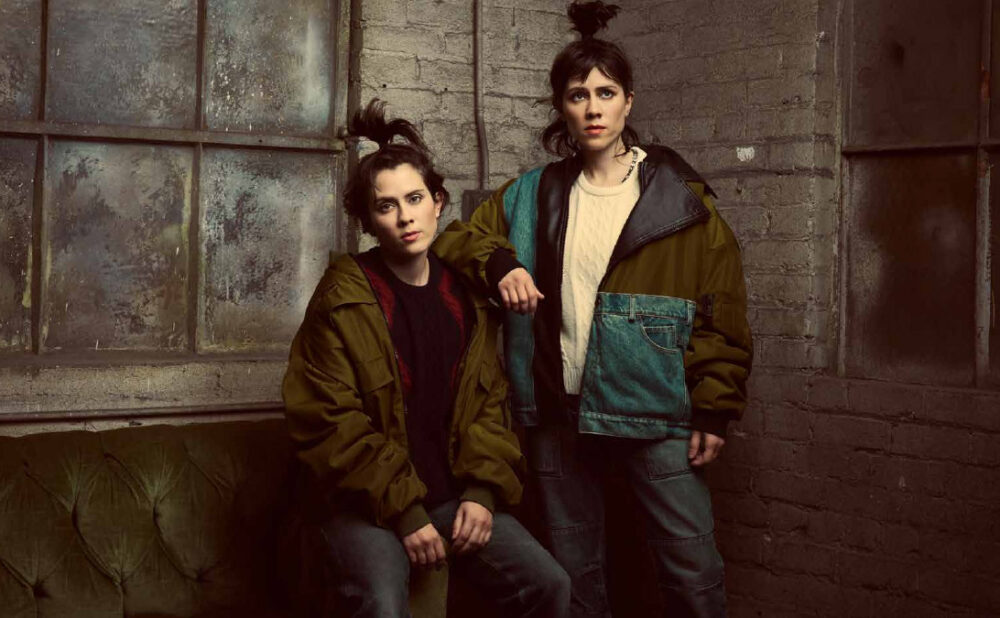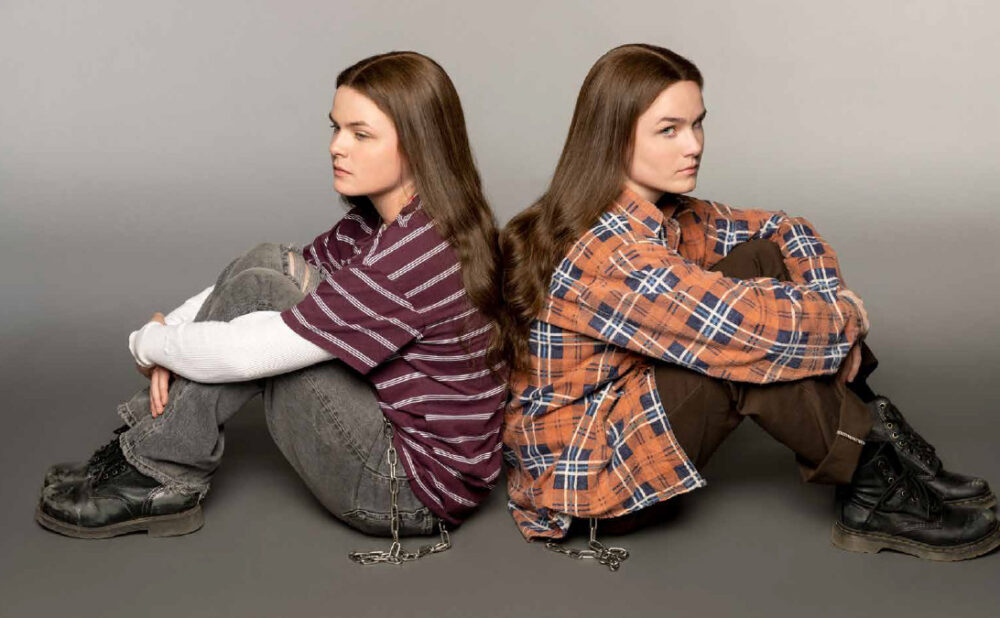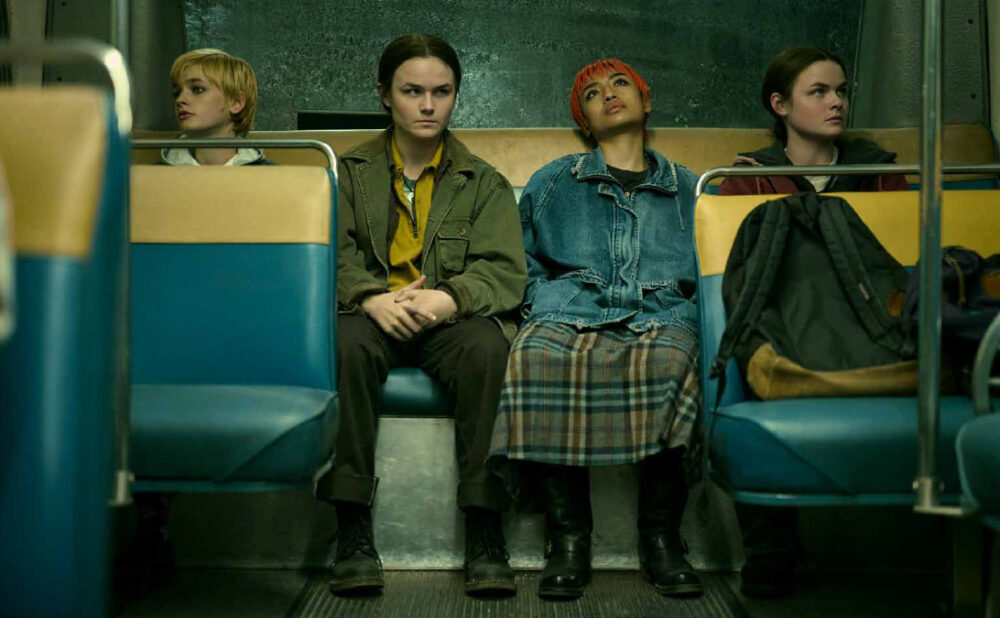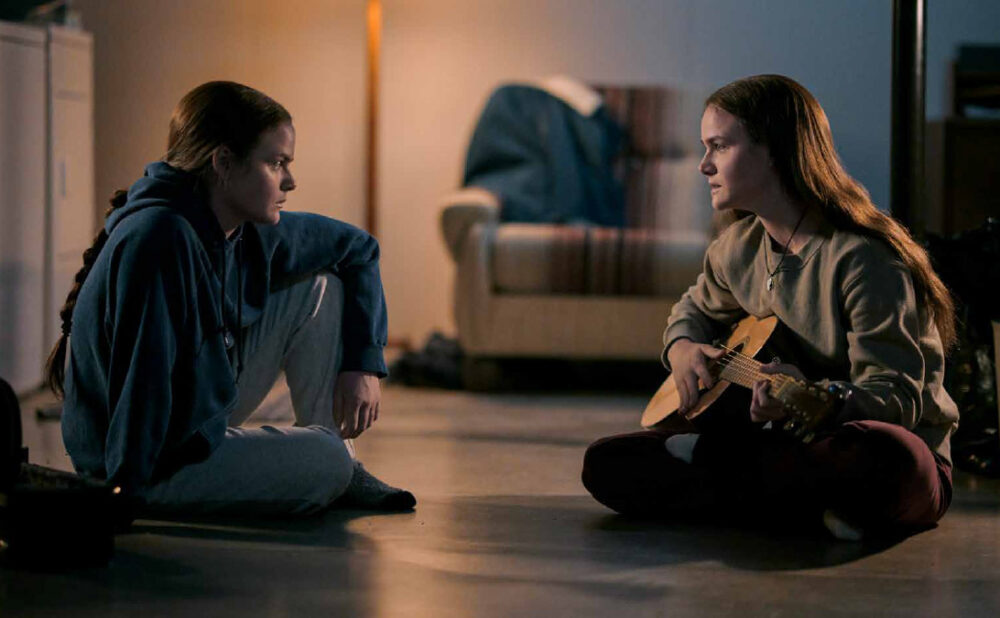Tegan and Sara “pass notes” in new series based on their memoir
Shared teenaged notes and letters at core of Prime Video’s High School
High School
Where: Prime Video
What: Series, 8 episodes, 30 mins.
When: Fri., Oct. 28 (three episodes), then weekly
Genre: Drama
Why you should watch: The past 20 years have seen Tegan and Sara Quin become household names for their Grammy-nominated and Polaris Award-winning music and also for their work as LGBTQ+ activists. High School, produced by the sisters and directed by their longtime friend Clea DuVall, intimately shows us all that it took for the sisters to get to this point. Based on Tegan and Sara’s bestselling memoir of the same name, High School is oftentimes gritty and raw, but so is teenagehood. With a brilliant score and a heart-wrenching commitment to depicting the ups and downs not only of growing up gay in Calgarian suburbs in the ’90s but also what it looks like to craft an identity that is all one’s own, High School reminds us of the possibilities the coming-of-age genre contains.
About halfway through the Amazon Original series High School, based off Tegan and Sarah Quin’s 2019 bestselling memoir of the same name, the girls’ friend Maya (Amanda Fix) asks Tegan (Railey Gilliland), “Did you get my letter?”
“Yes, I read it like five times,” Tegan replies. In reading the memoir, watching the series and speaking with the Grammy-nominated and Juno Award-winning sisters at this year’s Toronto International Film Festival (TIFF) (where the Clea DuVall- and Rebecca Asher-directed series premiered) this kind of letter-writing emerges as a subtle but direly crucial aspect in the story of High School and also the Quins’ lives.
“Tegan and I were not academically driven in high school, but here we were involved in what essentially was a creative writing exercise almost daily,” Sara tells me of their letter-writing as teens. “We were obsessed with writing; we were learning to talk about ourselves and to individuate and to be storytellers.”
The sisters turned to this trove of writing as they worked on their memoir and then the show. In the memoir and in the show, these notes — passed on lined paper torn from notebooks or in journals Tegan shared with her best friends — tend to function as sacred and weighty carriers of confessions of feelings and inner turmoil. They’re also straightforward descriptions of sequences of experiences or fights and work to document aspects of the Quins’ lives in remarkable detail. It’s impossible not to pick up on the significance of letter-writing in their lives.
“It’s really interesting actually, because when Seazynn [Gilliland, who portrays Sara] and Railey were in L.A. before we started shooting the show, their acting coach had suggested that they get journals and write about their experience but kind of write from the perspective of their character, which I thought was really interesting,” Tegan says. “And Railey called me one day and was like, ‘I’m at the mall, what kind of journal did you write in, in high school?’”
A form of note-writing even came into play as the sisters executive-produced the show. After initial and thoroughgoing talks with DuVall about potential avenues the show could take — “Clea flew up to Vancouver and it was so fun,” Tegan says, “She came and hung out with us, and we would go for dinners, we would spend all day talking about what the show could be, what the possibilities were.” — DuVall wrote the initial pitch for the show, they say, and then went on to sell it.
As DuVall and producer Laura Kittrell worked on worldbuilding and scriptwriting, they would send along scripts to Tegan and Sara.
“We would send back notes and talk about what felt right, what didn’t,” Tegan says. She says that as executive producers, their role in development was focused more on being a source of information and protecting their real-life family and friends from misrepresentation.
“Not that Clea and Laura were gonna run wild and have our mother end up in prison,” Tegan adds. “They were going to stay within the boundaries of the book; but right at the beginning, Clea called us and said, ‘How comfortable are you guys with us fictionalizing stuff?’ And we were just like, ‘Fuck yeah, fictionalize away’.”
Even so, this fictionalizing and formatting their life story for TV — that is, adding narrative arcs and the friction necessary for compelling drama — remained within the bounds of reality. This flexible straddling of the truth allowed Tegan to appreciate the show all the more when it premiered at TIFF.
“Seeing it with an audience and seeing how people were enjoying it and going through the emotions, I was like, ‘Thank goodness this is not a biopic, this is not everyone in costume pretending to be us and our friends and our family’,” she says.
“Because even I was really able to step back and enjoy it. This is a story about girls and queerdom and art and creativity in the ’90s and adolescence and all these things. And it didn’t feel like, ‘This is the Tegan and Sara story,’ ’cause it’s not. Because our story, even though it’s so unique to us in some ways, is everyone’s story. Being a fucking teenager is tough, and the ’90s were tough for queer people and being in a household with working parents and lusting after your friends — these are things that, when we put the book out, dudes, people of all ages, came up to us on the street and said, ‘I had no idea I could connect to your story’ and it’s like, yeah, adolescence is universal.”
In stark contrast to their memoir, which alternates between the girls’ accounts of adolescence in Calgarian suburbia, the series depicts a much more vibrantly populated world. In addition to Sara and Tegan portrayed by real-life twins Seazynn and Railey, respectively, we also see events through the points of view of their mother, here called Simone (Cobie Smulders), their step-father Patrick (Kyle Bornheimer), Sara’s girlfriend Phoebe (Olivia Rouyre) and Tegan’s friend Maya. It’s an alive and moving world, oftentimes the same events are depicted twice or three times, each time from a different angle and with added nuance and layers of meaning.
One of the show’s more stunning aspects is the amount of respect each and every single perspective is given. An adult character like Simone is depicted with her strengths but also with moments of weakness, her fears and anxieties given the space to cautiously unfurl in that hesitant, adult way. Teenage characters get the same respect, the events around them and impacting them are shown for how heavy they might feel, filtered through the 16-year-old gaze so prone to catastrophizing. A grounding for lying to a parent or being told sleepovers with certain friends are suddenly out of bounds — these events that, from an adult vantage point might seem trivial, are depicted in their earth-shattering weight through Sara’s and Tegan’s eyes.
“I think there is something special about the way the show shows both those sides,” says Tegan. “Because you have the parents who have emotional intelligence and you have the kids who are really tight [amongst themselves]; it creates this really interesting movement in every episode between them.”
Tegan and Sara go on to note that the show does a stellar job of poking holes in the parents’ supposed emotional intelligence, too, realistically depicting the aggravating habits adults have of walking circles around one another and not having the confidence to speak their minds to each other in the way that teens might. Despite the emotional intelligence the adults are supposed to have in comparison to the teens, the show doesn’t present them as sagely caricatures. Simone and Patrick often remain tight-lipped around one another, not able to voice their issues to each other in the way the teens communicate, confessing feelings in bursts of energy or through letters stuffed through vents in lockers.
This emotional turbulence and fallibility of adults is also something corroborated by real life, by the notes Tegan and Sara kept as teens.
“Our parents really did seem a little more emotionally turbulent,” Sara says. “And I know this because my mom and I have argued about it, but I have the receipts, I have the letters that I would write. We were privy to the complicated stuff that was happening between my mom and my stepdad.”
“How I remember it is that we weren’t paying attention to our parents,” Sara goes on. “But when I got the notes from high school, we were paying attention, we were writing about it. We were saying things like, ‘My mom and Bruce seem really mad at each other. They seem really, really unhappy right now. I wonder what’s gonna happen.’ So even though I didn’t remember that as being an anxiety that I was having at home, I had it.”
All roads lead back to the notes and letters. Often the notes seem to be the tether that loosely guides the show’s narrative back into the vicinity of truth after the twirls of fictionalization, walking its fine line or hovering just nearby.
When I first sit down with them in a lavish conference room within the Fairmont Royal York, I ask them whether this note and letter-writing, impacted them as lyricists. Indeed, so many of their beautiful lyrics are like daggers wrapped in silk, lacerating in their confessional honesty even as they twirl softly with their metaphoric turns and imagistic licks, their flow and dialogic complexity redolent of a varied and vast feminine history of letter writing.
“It was a way of keeping someone’s attention, you know?” Tegan says of writing letters to girls she liked. “And I think writing music was an extension of that. It was like, ‘Oh, now I can apply some of these pining, longing subtleties from my letters to lyrics,’ and then I could still make everyone pay attention, like, make this girl that I like sit and listen to me play it.”
Sara echoes this sentiment, painting an image she gleaned of herself as she read her old notes: a teen with a lot to say and not afraid to say it. It’s an image similar to the one the series itself paints: two teenage girls armed with a starry but stolid dream, determinedly navigating a complex world as they tease meaning, their own identity and love from its thorny grasp.
“I was utterly astonished by how much confidence I had when I went back to read the notes,” Sara says. “I used to write incredibly personal things. I had zero filter. I would write these ridiculous stream of consciousness, just abstract word salads, and then I would call girls. I would roll girls in. I would be like, ‘Okay, I’ll start with my best friend, and then if she’s busy and has to do homework, I’ll go to the next girl that I have the biggest crush on. And then after her I’ll call this girl. And I would read my poetry and my writing and my songs to them. I had so much confidence, even, honestly, to play music. Not just confidence to perform for people, but really that early instinct to record ourselves and listen to ourselves. We were not like, ‘Oh my god, we’re so bad.’ We were like, ‘I’m fucking amazing. You should really listen to this’.”









